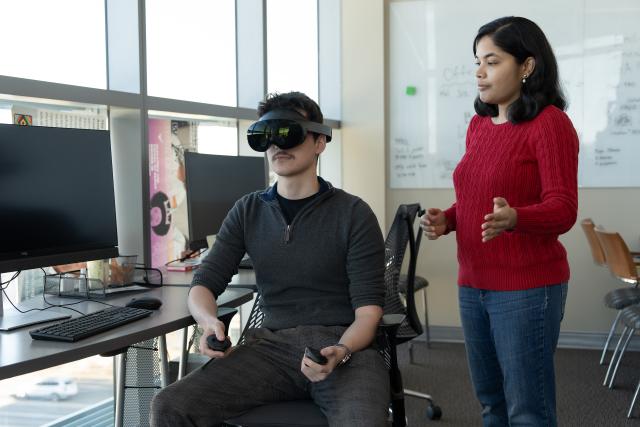Kean Researcher Works to Make Self-driving Cars Safer for Pedestrians

Assistant Professor Lakshmi Subramanian, Ph.D., and student researcher Brandon Mirabal use VR technology to research pedestrian safety.
A Kean University computer science researcher is studying potential ways to enhance communication features on self-driving cars to improve the safety of pedestrians.
Assistant Professor Lakshmi Subramanian, Ph.D., of the Department of Computer Science and Technology, is leading a team of Kean undergraduate researchers who are conducting research to understand how pedestrians behave when crossing streets in the era of autonomous vehicles.
At Kean, where she joined the faculty two years ago, Subramanian and her team are using virtual reality headsets to study and understand how adult pedestrians behave when crossing multi-lane roads in the presence of self-driving vehicles.
“This type of study would be dangerous to do in the real world, so we are leveraging the power of virtual reality,” she said. “Most research in this area deals with single-lane roadways. Real-world traffic is more complicated, and so our research has implications for scalability of autonomous vehicles.”
Subramanian began exploring the topic of pedestrian safety and self-driving cars as a doctoral student at the University of Iowa, testing ways to have autonomous cars signal safe crossing to pedestrians. Without a driver at the wheel, pedestrians cannot make eye contact or get other cues to let them know it’s safe to cross.
Kean Professor and Chair of the School of Computer Science and Technology Patricia Morreale, Ph.D., said Subramanian’s work potentially affects a broad swath of people.
“We will all encounter more self-driving cars on the road in the years to come, and we’ll all have to learn how to safely maneuver around them,” Morreale said. “Dr. Subramanian's research has important implications for the people who design driverless cars, policymakers who deal with transportation issues, and those of us who rely on cars and roadways to go about our daily lives.”
As self-driving cars become more common, manufacturers and policymakers have explored how to add visual cues to vehicles to help pedestrians make decisions.
In Iowa, Subramanian’s research focused on children. Using a life-sized video CAVE immersive virtual environment, they crossed a virtual street as an autonomous car, equipped with a dome-shaped signal light, approached. Researchers examined two potential safety enhancements – having the car signal with a green light early as the car was still in motion, or signal late only when the car came to a full stop at a midblock intersection.
Results, published in the journal Accident Analysis & Prevention, showed children made the safest crossing decision if the car signaled at a full stop.
“These results have direct implications for improving policies and enhancing the safety of young and adult pedestrians,” Subramanian said. “It’s a great opportunity for students to do research.”
At Kean, the University’s CAVE-VR simulation technology can help power this type of research. The technology was secured through the National Science Foundation Major Research Instrumentation Program in 2010 by Morreale; David Joiner, Ph.D., acting associate dean of the School of Integrative Science and Technology; and George Chang, Ph.D., dean of The Dorothy and George Hennings College of Science, Mathematics and Technology.
“Leveraging the immersive, data-driven environments that the CAVE provides can achieve groundbreaking advancements,” Chang said. “Integrating this technology into research on pedestrian crossings and self-driving cars can revolutionize the way we study and design safe, efficient autonomous systems.”
For Subramanian’s students, working on real-world research has also opened doors to academic achievement and professional success.
Brandon Mirabal of Avenel, a junior majoring in computer science, designed virtual scenes and built code for Subramanian’s current research. He said the project boosted his goals of attending graduate school or perhaps working in software development after graduation. He presented a poster based on a preliminary result of his research experience that won second place at the Great Minds in STEM conference in Fort Worth, Texas, in November.
“The judges thought it stood out because it focused on the safety of pedestrians in the new world we are living in,” Mirabal said. “A lot of other projects covered training AI models and segmentation, whereas ours involved real participants reacting to different scenarios. In our current research, it will be exciting to see how that scales.”